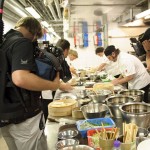On location: MasterChef
 Produced in Sydney by Fremantle Media Masterchef hasturned into a ratings blockbuster for Network Ten. Peter Galvin sneaked into their kitchen and found out how they’ve set a standard for the genre.
Produced in Sydney by Fremantle Media Masterchef hasturned into a ratings blockbuster for Network Ten. Peter Galvin sneaked into their kitchen and found out how they’ve set a standard for the genre.
According to a Ten spokesperson, Masterchef scored a 1.96 rating for one Sunday in June and averages 1.29 million viewers a night “dominating its timeslot”. Combining the reality show with the popular but much-less sensational “cooking show” program, the series, whose concept originated in the UK, offers a high-turn over, high-volume production challenge for cast and crew. “Sometimes we have a crew of 100 to cover the action,” says Judy Smart, series producer. Based in Alexandria, in an industrial estate in the city’s inner-south west, MasterChef is made in a purpose built set, in what was once a warehouse.
The show runs Sunday to Friday. The series began with fifty finalists, selected from an open audition process. Each week the contestants compete against one another in a series of challenges, judged by award-winning chefs and a food critic. and each week two contestants are eliminated. The prize offers a publishing deal and an opportunity for the winner to “live their dream, to become a professional MasterChef.”
“Each day of shooting is an episode,” says Smart. Post-production is based in Crows Nest. “We use 20 offline edit suites and we do 72 episodes in three and a half months.” Each week TEN puts to air three hour-long episodes and three half hours.
“It’s innovative in what we are trying to do in terms of the sheer volume of output and the technical difficulties that arise from that,” says series director Kate Douglas-Walker. “To shoot up to 20 people cooking 20 different dishes and getting the coverage on that right… directorially, it’s working out a shooting style that covers everything well.”

